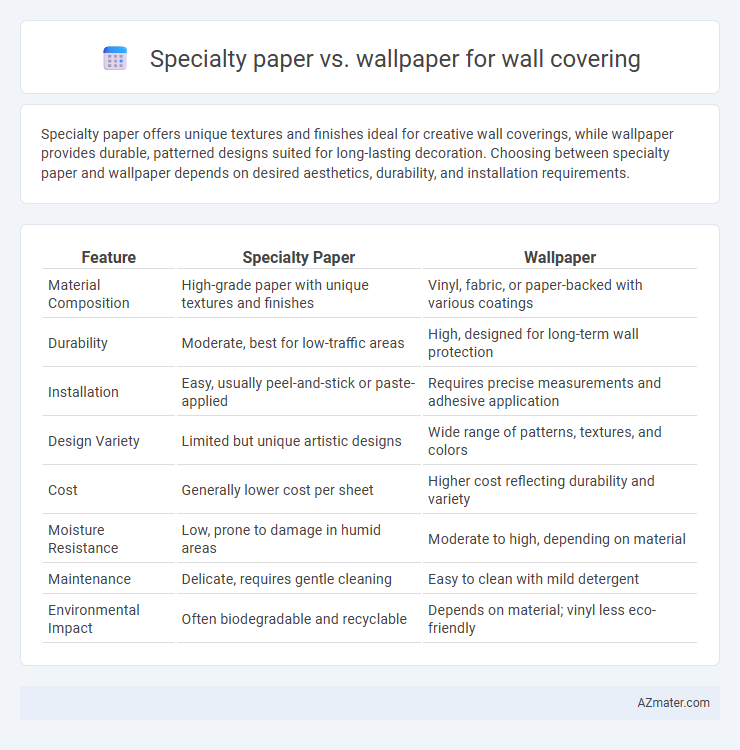Specialty paper offers unique textures and finishes ideal for creative wall coverings, while wallpaper provides durable, patterned designs suited for long-lasting decoration. Choosing between specialty paper and wallpaper depends on desired aesthetics, durability, and installation requirements.
Table of Comparison
| Feature | Specialty Paper | Wallpaper |
|---|---|---|
| Material Composition | High-grade paper with unique textures and finishes | Vinyl, fabric, or paper-backed with various coatings |
| Durability | Moderate, best for low-traffic areas | High, designed for long-term wall protection |
| Installation | Easy, usually peel-and-stick or paste-applied | Requires precise measurements and adhesive application |
| Design Variety | Limited but unique artistic designs | Wide range of patterns, textures, and colors |
| Cost | Generally lower cost per sheet | Higher cost reflecting durability and variety |
| Moisture Resistance | Low, prone to damage in humid areas | Moderate to high, depending on material |
| Maintenance | Delicate, requires gentle cleaning | Easy to clean with mild detergent |
| Environmental Impact | Often biodegradable and recyclable | Depends on material; vinyl less eco-friendly |
Introduction to Wall Covering Options
Specialty paper and wallpaper are popular wall covering options that enhance interior design with varying textures, patterns, and finishes. Specialty paper offers unique materials such as handmade fibers, embossed effects, and eco-friendly compositions, providing customization and sustainability benefits. Wallpaper features diverse styles, including vinyl, non-woven, and fabric-backed options, known for durability and ease of maintenance in residential and commercial spaces.
What is Specialty Paper?
Specialty paper refers to high-quality, uniquely textured or coated paper designed for specific applications, including wall covering, where it offers durability, moisture resistance, and distinct aesthetic features. Unlike traditional wallpaper, specialty paper can include materials such as rice paper, handmade textured papers, or synthetic fibers enhanced for performance and artistic effect. Its versatility allows for customization in interior design, providing an alternative to conventional wallpaper that emphasizes both functionality and decorative appeal.
What is Wallpaper?
Wallpaper is a decorative wall covering made from paper, vinyl, or fabric materials, designed to enhance interior spaces with patterns, textures, and colors. It offers a variety of styles, including traditional, textured, and peel-and-stick options, providing durability and ease of application compared to specialty papers. Unlike specialty paper used primarily for arts and crafts, wallpaper serves a functional role in home decor by protecting walls and adding visual interest.
Material Composition Differences
Specialty paper wall coverings are primarily made from cellulose fibers and may include additional coatings or textures such as vinyl for durability and moisture resistance. Wallpaper often incorporates multiple layers including vinyl, fabric, or non-woven materials, enhancing its strength and washability compared to traditional specialty paper. The material composition of wallpaper generally offers greater resilience and design versatility, making it suitable for high-traffic or moisture-prone areas.
Design and Aesthetic Variations
Specialty paper offers intricate textures and unique finishes such as metallics, embossing, and hand-painted effects, catering to bespoke interior designs and artistic expression. Wallpaper provides an extensive range of patterns, colors, and styles, from classic damask to modern geometric prints, enabling versatile customization for different rooms and moods. Both options enhance wall aesthetics, but specialty paper stands out for its tactile appeal, while wallpaper excels in pattern variety and ease of installation.
Durability and Maintenance
Specialty paper offers moderate durability with resistance to fading and minor abrasions, making it suitable for low-traffic areas, while wallpaper generally provides enhanced durability with thicker materials and protective coatings ideal for high-traffic or moisture-prone environments. Maintenance of specialty paper involves gentle cleaning with a dry cloth, as it is more susceptible to damage from water or harsh cleaning agents, whereas wallpaper can typically withstand regular wiping and occasional spot cleaning due to its water-resistant finishes. Choosing between specialty paper and wallpaper for wall covering depends on the required durability level and ease of maintenance tailored to the specific room conditions.
Installation Processes Compared
Specialty paper typically offers a smoother installation process due to its lighter weight and flexibility, making it easier to align and adjust on walls. Wallpaper often requires more preparation, such as applying paste with precision and managing heavier rolls that can lead to bubbling or misalignment if not carefully handled. Choosing specialty paper can reduce installation time and errors, which is beneficial for DIY projects or quick renovations.
Cost Analysis: Specialty Paper vs Wallpaper
Specialty paper typically costs less per roll compared to wallpaper, making it a budget-friendly option for temporary or low-traffic spaces. Wallpaper, especially designer or textured varieties, often involves higher upfront costs but offers greater durability and a longer lifespan, potentially reducing replacement frequency. When factoring in installation expenses, wallpaper may require professional services due to its complexity, while specialty paper can often be applied as a DIY project, further influencing overall cost efficiency.
Environmental Impact and Sustainability
Specialty paper for wall covering often boasts eco-friendly properties due to the use of recycled fibers and biodegradable materials, reducing landfill waste and carbon footprint. Wallpaper, especially vinyl-based types, typically involves non-biodegradable plastics and toxic chemicals, contributing to lasting environmental pollution. Opting for sustainably sourced specialty paper reduces resource consumption and promotes a circular economy in interior design.
Choosing the Right Option for Your Space
Specialty paper offers unique textures and finishes ideal for accent walls, while wallpaper provides diverse patterns and durability for full-room coverage. Selecting the right wall covering depends on factors like room usage, moisture levels, and desired aesthetic impact. Consider specialty paper for artistic statements and wallpaper for versatile, long-lasting designs that enhance space functionality and style.

Infographic: Specialty paper vs Wallpaper for Wall covering
 azmater.com
azmater.com